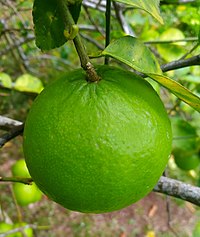
Photo from wikipedia
Background and Aims Two main types of triploid limes are produced worldwide. The 'Tahiti' lime type (Citrus latifolia) is predominant, while the 'Tanepao' type (C. aurantiifolia) is produced to a… Click to show full abstract
Background and Aims Two main types of triploid limes are produced worldwide. The 'Tahiti' lime type (Citrus latifolia) is predominant, while the 'Tanepao' type (C. aurantiifolia) is produced to a lesser extent. Both types result from natural interspecific hybridization involving a diploid gamete of C. aurantiifolia 'Mexican' lime type (itself a direct interspecific C. micrantha × C. medica hybrid). The meiotic behaviour of a doubled-diploid 'Mexican' lime, the interspecific micrantha/medica recombination and the resulting diploid gamete structures were analysed to investigate the possibility that 'Tahiti' and 'Tanepao' varieties are derived from natural interploid hybridization. Methods A population of 85 tetraploid hybrids was established between a doubled-diploid clementine and a doubled-diploid 'Mexican' lime and used to infer the genotypes of 'Mexican' lime diploid gametes. Meiotic behaviour was studied through combined segregation analysis of 35 simple sequenbce repeat (SSR) and single nucleotide polymorphismn (SNP) markers covering the nine citrus chromosomes and cytogenetic studies. It was supplemented by pollen viability assessment. Key Results Pollen viability of the doubled-diploid Mexican lime (64 %) was much higher than that of the diploid. On average, 65 % of the chromosomes paired as bivalents and 31.4 % as tetravalents. Parental heterozygosity restitution ranged from 83 to 99 %. Disomic inheritance with high preferential pairing values was deduced for three chromosomes. Intermediate inheritances, with disomic trend, were found for five chromosomes, and an intermediate inheritance was observed for one chromosome. The average effective interspecific recombination rate was low (1.2 cM Mb-1). Conclusion The doubled-diploid 'Mexican' lime had predominantly disomic segregation, producing interspecific diploid gamete structures with high C. medica/C. micrantha heterozygosity, compatible with the phylogenomic structures of triploid C. latifolia and C. aurantiifolia varieties. This disomic trend limits effective interspecific recombination and diversity of the diploid gamete population. Interploid reconstruction breeding using doubled-diploid lime as one parent is a promising approach for triploid lime diversification.
Journal Title: Annals of Botany
Year Published: 2018
Link to full text (if available)
Share on Social Media: Sign Up to like & get
recommendations!